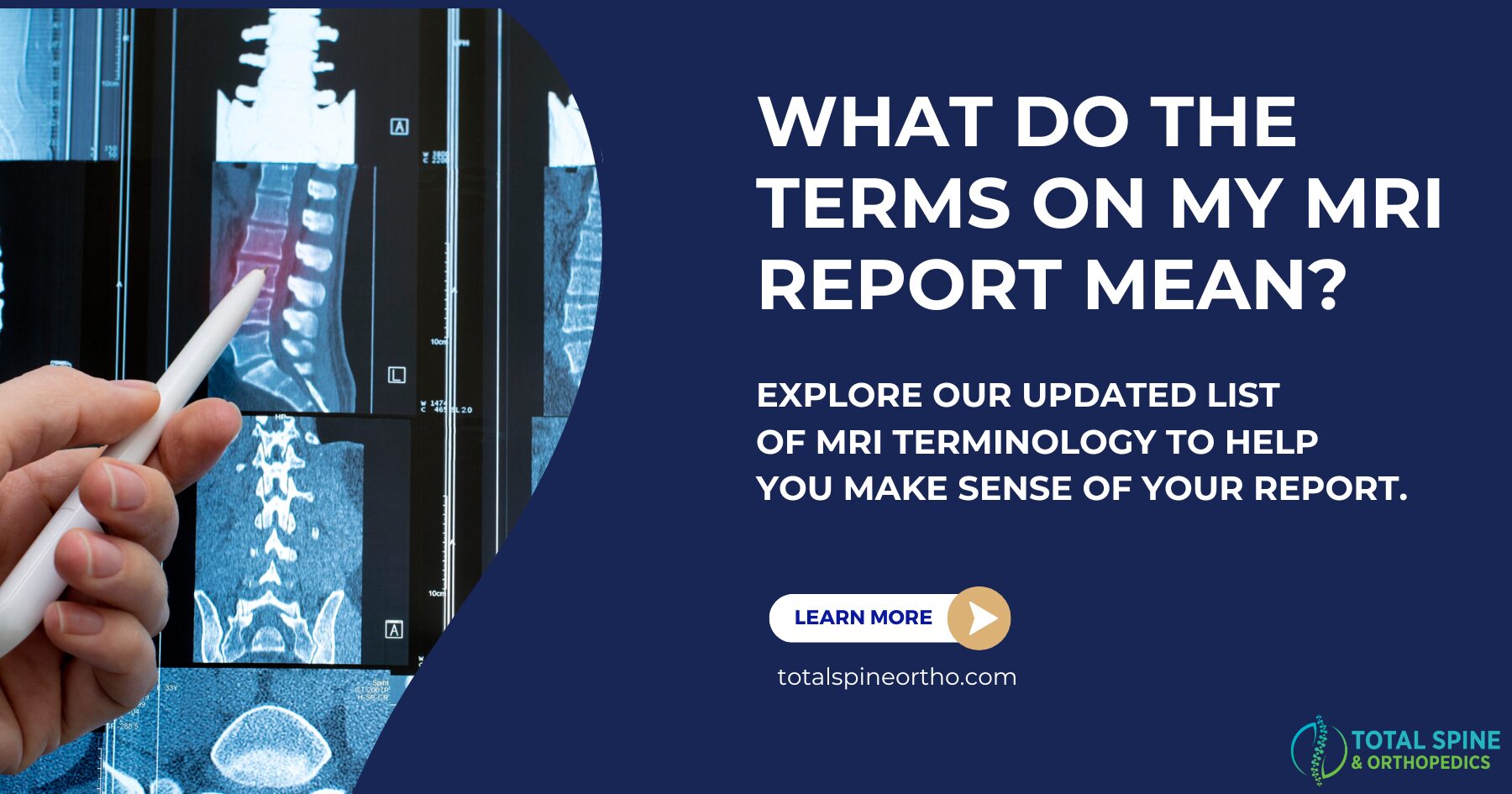If you’re like many of the patients we’ve seen, you’ve probably had an MRI, CT Scan, or other imaging of your spine completed at some point. These types of diagnostic scans are essential in properly diagnosing and treating the root causes of neck and back pain. Unfortunately, once you have your report you may find it confusing to read, and full of medical terminology you may be unfamiliar with. In this article, we are going to unpack a typical MRI report and look at the definitions and meanings of some commonly seen terms.
Disclaimer: This article is to be used for educational purposes only and is not a substitute for a diagnosis from a physician. Please consult with your physician before attempting any treatment regimen or diagnosis.
Total Spine and Orthopedics offers a Free MRI Review that allows you to have your MRI imaging and report reviewed by our team of physicians who can answer any outstanding questions that you may have.
Common MRI Terms And Their Meaning
Lumbar/Lumbar Spine refers to the lower region of your back defined by the area encompassing the lower 5 vertebrae within your spine (L1-L5).
Cervical/Cervical Spine refers to the upper region of your neck defined by the area encompassing the upper 7 vertebrae within your spine (C1-C7).
Thoracic/Thoracic Spine refers to the middle region of your spine defined by the area encompassing the middle 12 vertebrae within your spine (T1-T12).
Herniated Discs as well as a variety of similar terms such as bulging discs, ruptured discs, slipped discs, disc protrusions, or prolapsed discs are one of the most common terms seen on an MRI of the spine. This term indicates that one of the sponge-like discs between your vertebrae has become damaged, allowing the jelly-like inner portion of the disc (nucleus pulposis) to leak outwards. Treatment options may include medication, physical therapy, and steroid injections. Surgery may become necessary if the disc is unable to heal on its own and non-invasive treatments are ineffective at treating symptoms such as back or neck pain, or pain/weakness/tingling/numbness in the arms or legs.
Annular Tear(s) are a condition that occurs when the outer layer of one of your spinal discs has become damaged. On their own, annular tears are very rarely symptomatic and typically heal on their own. Annular Tears may progress into Herniated Discs if the inner material of the disc (nucleus pulposus) is able to leak outside of the disc through the annular tear.
Degenerative Disc Disease is a broad diagnosis typically caused by the gradual wear and tear of the discs between your spinal vertebrae. In many cases this condition will result in no symptoms and will not require treatment, however, loss of flexibility, bone spurs, and pinched nerves can occur as a result of this condition and may require treatment depending on the severity and prevalence of the symptoms.
Spinal Stenosis refers to a condition where the interior spaces within the spine have become narrowed. Spinal stenosis does not always require treatment, although it may be further linked to radiculopathy (nerve root impingement) when it is identified on an MRI. You may also see terms such as Foraminal Stenosis, Lateral Recess Stenosis, Far Lateral Stenosis, and Central Canal Stenosis which all refer to specific types and locations of spinal stenosis. Your physician will be able to provide more information on what treatment options are available for your specific type of stenosis.
Radiculopathy, also known as a nerve root impingement is a wide variety of symptoms caused by a pinched nerve root within the spinal column. Potential causes include herniated/bulging discs, bone spurs, spinal stenosis, and a variety of other conditions. Treatment options include anti-inflammatory/muscle relaxing medication, steroid injections, or surgery.
Vertebral compression fracture: This term indicates that a collapse of a vertebra or a break in the bone has occurred within your spine. This may be due to trauma caused by an accident, or a gradual weakening of the bones within the spine. This condition is also commonly associated with osteoporosis.
Kyphosis/Lordosis: These two terms both refer to an abnormal curvature of the spine. Mild kyphosis or lordosis typically requires no treatment, however severe symptomatic kyphosis or lordosis may require treatments such as physical therapy, anti-inflammatory drugs, or a spinal fusion.
Sciatica is a type of pain that radiates along the sciatic nerve from the lower back into both legs. Sciatica is typically caused by a herniated disc or bone spur pressing onto the sciatic nerve, and typically only affects one side of the body at a time. Potential treatments include anti-inflammatory and/or muscle relaxant medication, physical therapy, and steroid injections. Surgery may be required if conservative treatment options such as the above fail to provide adequate symptom relief.
Spondylosis refers to age-related changes in the spine, often described as "spinal arthritis." These changes can include the development of bone spurs (osteophytes) and degeneration of the intervertebral discs. Spondylosis is a common finding in older adults and can lead to stiffness and discomfort.
Facet Arthropathy: The facet joints are small joints located between and behind adjacent vertebrae. Facet arthropathy refers to degenerative changes in these joints, similar to arthritis in other parts of the body. This condition can cause localized pain and stiffness and may contribute to the narrowing of the spaces where nerves exit the spine.
Disc bulges occur when an intervertebral disc extends beyond its normal boundary but doesn't rupture or herniate. This bulging can compress nearby nerves or the spinal cord, potentially causing pain or other neurological symptoms. It's a common finding that may or may not be symptomatic.
Foraminal stenosis refers to the narrowing of the foramina, which are openings in the vertebrae through which spinal nerves exit. This narrowing can be caused by bone spurs, disc bulges, or other degenerative changes and can lead to nerve compression, resulting in pain, numbness, or weakness in the extremities.
Myelopathy is a term used to describe spinal cord dysfunction due to compression. This condition can result from various causes, including herniated discs, spondylosis, or spinal stenosis. Symptoms of myelopathy can include difficulty walking, neck, arm, leg or lower back pain, loss of fine motor skills, and problems with bladder or bowel control.
Osteophytes, commonly known as bone spurs, are bony projections that form along the edges of bones, particularly in the spine. These spurs can develop as part of the aging process and are often associated with spondylosis. While osteophytes themselves are usually not painful, they can contribute to nerve compression and other spinal issues.
Spondylolisthesis occurs when one vertebra slips forward over the one below it. This condition can result from congenital defects, degenerative changes, or trauma. It can cause back pain, as well as nerve compression symptoms if the slipped vertebra impinges on spinal nerves.
Modic changes are changes in the vertebral bone marrow adjacent to the endplates of the intervertebral discs, visible on MRI. These changes are classified into three types based on the appearance on MRI and are associated with disc degeneration and back pain. Type 1 Modic changes indicate inflammation, Type 2 indicates fatty degeneration, and Type 3 indicates sclerosis or bone hardening.
Ligamentum Flavum Hypertrophy: The ligamentum flavum is a ligament that runs along the back of the spinal canal. Hypertrophy refers to the thickening of this ligament, which can occur with aging and degenerative changes. This thickening can contribute to spinal stenosis by reducing the space available for the spinal cord and nerves.
Syrinx refers to a fluid-filled cavity within the spinal cord, often associated with conditions like syringomyelia. This cavity can expand and cause damage to the spinal cord, leading to a range of neurological symptoms including pain, weakness, and loss of sensation.
Disc Desiccation is a loss of water content in the intervertebral discs, leading to disc shrinkage and potential reduction in disc height, often part of the natural aging process.
Endplate Changes are alterations in the bony endplates of vertebrae adjacent to intervertebral discs, often related to degeneration and seen as Modic changes on MRI.
Transitional Vertebra is a congenital anomaly where a vertebra has characteristics of two different types of vertebrae, such as a lumbarized S1 or a sacralized L5, which can sometimes cause back pain or be asymptomatic.
Cauda Equina Syndrome occurs when the bundle of nerves at the lower end of the spinal cord (the cauda equina) becomes compressed. This condition can cause severe lower back pain, loss of sensation in the legs or saddle region (around the inner thighs), and loss of bladder or bowel control.

Still have questions about these or other terms on your MRI report? Our Free MRI review is a great way to have your individual MRI and report reviewed by our team of physicians who can answer any questions that you have and review what treatment options are available. Get all the details and sign up by here.


